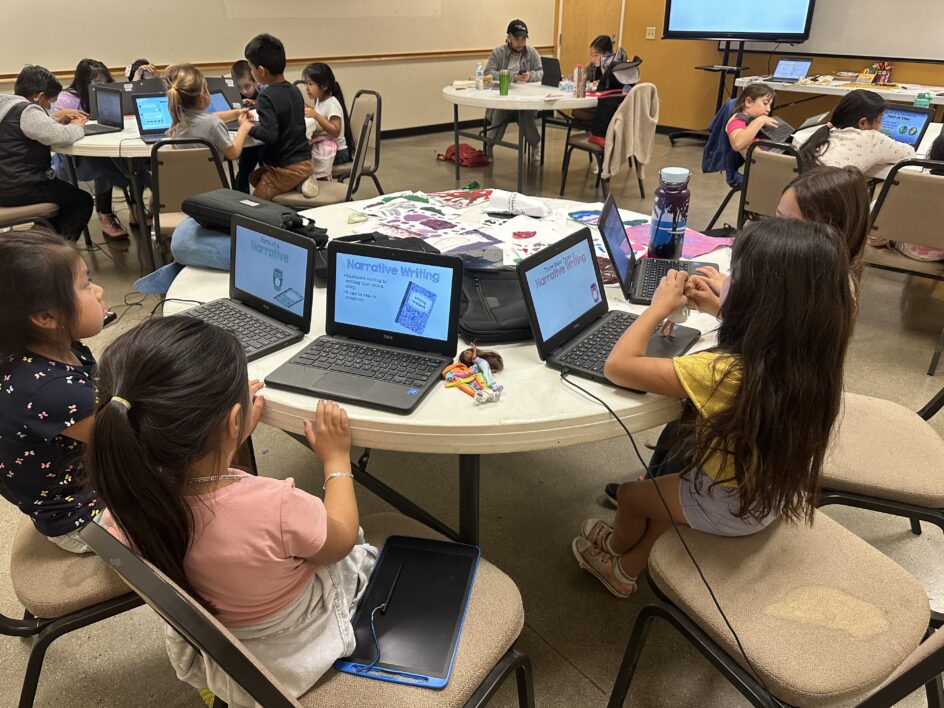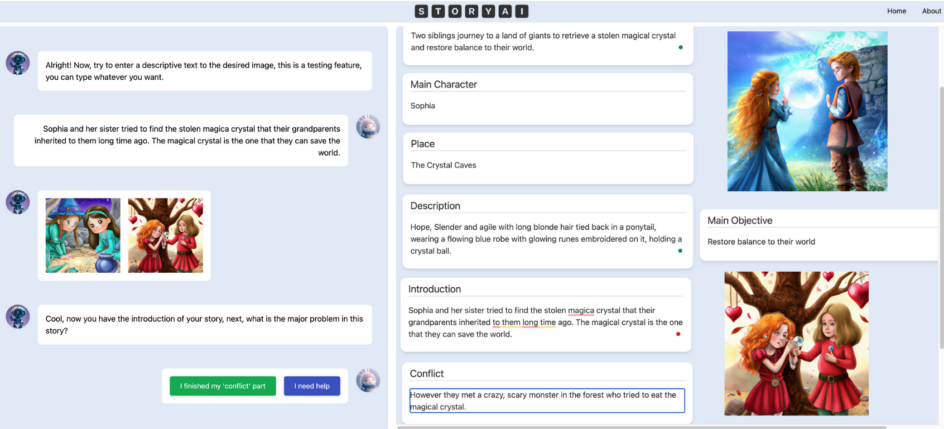StoryAI App Engages Students in Learning
The Delhi Center, a nonprofit community center in Santa Ana, provides a variety of academic enrichment programs for children from low-income families. In partnership with UC Irvine, one such program offers a week-long class focused on technology and engineering.
“Talented instructors provide children ages 5 to 13 with advanced and complex yet age-appropriate technology classes covering AI, algorithm storytelling, conductivity, engineering, coding and much more,” says Youth Programs Manager Miguel Torres. “The children at the Delhi Center love these classes and learn tons about these vital subjects.”
Two offerings of the class this year included one-hour sessions with StoryAI, a storytelling application that leverages artificial intelligence (AI) for literacy development. In each session, 30 students, split across three age groups, worked with the novel platform.
StoryAI’s lead designer, Ariel Han, first started working on the educational content-creation platform as a Ph.D. candidate in UCI’s Donald Bren School of Information and Computer Sciences (ICS). “We conducted two sets of studies, one in spring and one in summer, with students at Delhi using StoryAI for narrative writing,” says Han, now a postdoctoral scholar at USC. “The kids really liked it. They got personalized feedback and attention from the AI agent, so they felt more engaged compared to writing on their own.”

Learning with StoryAI
“Hi, my name is Storybot! What is your name?”
This friendly introduction starts the conversation between StoryAI and the student. From there, students can select written or spoken text from Storybot and can request a translation if needed.
“All of the students [at Delhi] spoke English as a second language, so having the translation option helped,” says Han. Students also benefited from the individualized learning that stemmed from the back-and-forth conversations about the story genre, character descriptions, setting, narrative development and graphics.
“It helped me develop the story step by step, and engaged me with compliments,” said one student. “The AI is actually paying attention to what I’m saying.”

Han and her team are now taking the feedback gained from working with the Delhi Center students to update features and functionalities. The team includes Informatics Professor Kylie Peppler, who served as Han’s Ph.D. advisor.
“StoryAI is really about the process of writing, not the product,” says Peppler. “We’re trying to get kids interested in and iterating on different kinds of stories and thinking about genre and the ways of writing.”
At the same time, students also learn about AI and how to use this technology in positive ways. “It’s amazing that within just a few days of instruction, we saw significant gains in AI literacy, which was really exciting,” says Peppler. “They also started to recognize the biases that are in AI,” she adds. For example, StoryAI will ask students if they want to add any images to their story and will generate options based on a written description.
“The kids start to see that it’s just pulling from what is already out there on the Internet,” says Peppler, “which is a reflection of society itself.” [When requesting a photo of a “girl with brown hair and brown eyes,” the initial images offered are of a girl with fair skin, unless ethnicity or skin tone is added to the description.]
“Teaching children about AI and using the story-creation platform at an early age empowers children not just to use technology, but to shape the future with it,” says Torres, “ensuring they become creators and leaders in a world increasingly driven by intelligent systems that will shape our entire existence.”
Next Steps
StoryAI received nearly $50,000 as a UCI Beall Proof of Product Awardee, so the team is now using the PoP funds to iterate the design and conduct more user studies. UCI Beall Applied Innovation works to accelerate the pathway to market for promising UCI discoveries.
In addition to working with students, Han and Peppler are also introducing StoryAI to educators. “There’s a fear that AI is going to replace teachers,” says Peppler, “but when you offer a tool like StoryAI, people realize it can augment their teaching.”
Han gave a live demo of StoryAI to around 100 educators at the AI Summit, a gathering hosted by the Anaheim Union High School District this summer. Teachers learned about the various options, including narrative writing (levels 1 and 2), opinion writing, interactive storytelling and AI literacy.
The teachers gave a lot of feedback, much of which focused on customizable features related to grade level, writing topics and the amount of AI-based suggestions.
“Teachers want to customize the AI suggestion level, because it depends more on the students’ abilities than age or grade level,” says Han. “If the student is already fluent in writing and language, the teachers want to be able to pick a higher level, which offers fewer suggestions. We want to put teachers in the driver’s seat.”
The reality is that teachers don’t have enough time to work one-on-one with every single student in class, so StoryAI presents a unique tool for augmenting the learning environment. “When you ask students how they view StoryAI,” says Peppler, “they really talk about it as a peer, as a collaborator.”
This type of engagement can help spark a love of learning. Torres speaks to the ways in which this helps empower underserved low-income children at the Delhi Center, encouraging an interest in science, technology, engineering, art and mathematics (STEAM). “Children are being exposed to knowledge that will help them thrive academically and, later, economically. As their interest in STEAM grows and their curiosity expands, they are more likely to pursue advanced careers.”
— Shani Murray